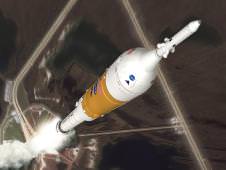[/caption]
Just one week after the first test flight test of the Ares I-X rocket, NASA says it may decide to cancel a follow-up launch called Ares 1-Y, which wasn’t scheduled until 2014. Reportedly, program managers recommended dropping the flight because, currently, there isn’t the funding to get an upper stage engine ready in time. The test flight may be replaced with a new, still undefined test flight in 2012 or 2013. “It simply does not fit where we are headed,” said Jeff Hanley, Constellation Program manager was quoted in NASA’s Constellation Blog. “The test vehicle was intended to meet evolving needs but the current configuration is too different from what the program requires to certify the Ares/Orion vehicle systems.”
Depending on whether the Obama administration decides to continue the Ares I program, this decision may be moot. Earlier this week Sen. Bill Nelson said Obama may make a decision on NASA’s future path, based on the report by the Augustine Commission, by the end of November.
At a press conference last week Hanley said the team continually assesses their flight test program. This week managers met and decided that the Ares I-Y flight fell too late in the vehicle development phase to provide useful information and lacks key elements to make it a true validation of the flight vehicle’s systems.
Originally, the I-Y test was planned for 2012. It was to be a suborbital flight to test a five-segment booster, a flight production upper stage, a functional command module and launch abort system and a simulated encapsulated service module, but without a J-2X engine.
By fall 2008, program managers were already looking at changing direction for the Ares I-Y test to improve the overall program’s chances of flying a full test vehicle by 2014. Now, with the Constellation Program nearing its preliminary design review and with maturing vehicles and systems, managers agree the I-Y test objectives can be achieved through other tests already in the manifest.
NASA is now studying the costs and benefits of going ahead with a 2012 launch previously called “Ares I-X prime” that would flight-test a full five-segment Ares I solid-fuel first stage and the Orion crew exploration vehicle launch abort system at high altitude.
Stay tuned.
Sources: NASA Constellation Blog, Aviation Week


I’m not suprised, nor do I care to much. We don’t spend enough money toward space exploration, and the money we do spend gets put into similar idea’s over and over again.
Obama and his government just don’t care about NASA,
yet another one of his promises “To restore science to its rightful place” proves hollow.
interesting. the only 2 comments i see are “don’t care” comments
nice of you guys to comment when you have nothing to do but complain.
why do you even bother?
tater1337, I did point out why I don’t care. You, however just complained about me complaining. It’s ok, you are entitled to your opinion and your thoughts have contributed greatly to the topic. Thank you.
It seems this is because of fiddling with the upper stage.
The point of Ares I-Y was to test the abort system in flight. So if the second stage motor that’s been delayed could have been replaced by so many bags of rocks… why wait to develop it?
Grab a five segment booster, the LAS, a boiler plate and launch it.
Ta-da, Ares I-X “Prime”, a year early.
How is that a bad thing?
The vultures are circling
I wasn’t too entirely impressed with the Ares 1 test upon seeing the second stage tumble after separation and almost collide with the first stage! THAT was a close one. Was that planned? I don’t think so….
If the second stage rocket failed during a manned flight and then tumbled, would the escape rockets be guaranteed to pull the command module away from the stack?
And then, TWO of the three main chutes failed and did not function at 100%. NASA meanwhile calls it a complete success. Go figure…
I know, I know the mission’s main goals were achieved. Vibration analysis and flight dynamics parameters were gathered, but regardless, it appeared to be a rather an ‘iffy’ flight from my point of view.
According to claimed insider posts on SDC, the tumble maneouvre was planned and worked as expected.
The tumbling was predicted by the models they used, which is logical if you know that the upper part is unpowered and has no steering capacities.